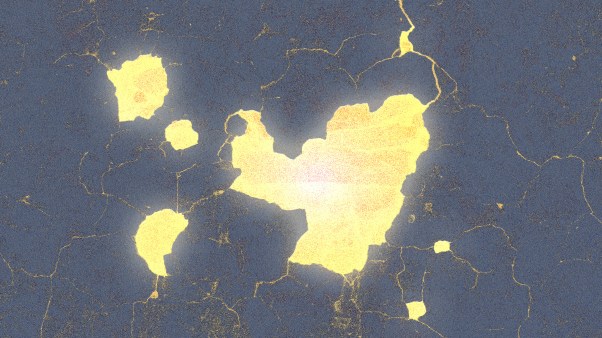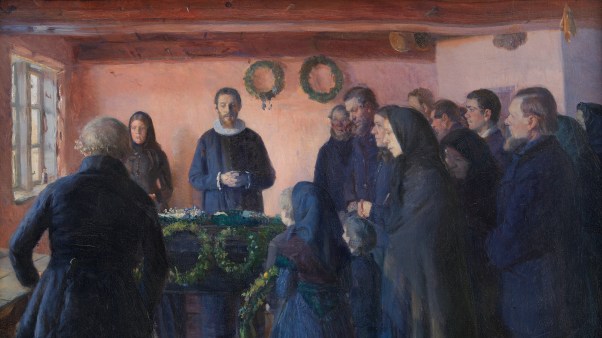So are you going to write about the Nephilim? This was the question several friends asked me after I signed a contract to write The Characters of Creation, a book about the first few chapters of the Bible. I didn’t think I could avoid writing about them, given how they show up in Genesis 6, one of Scripture’s more bizarre chapters.
The Characters of Creation: The Men, Women, Creatures, and Serpent Present at the Beginning of the World
Moody Publishers
192 pages
$13.19
As someone who has confidence in the authority and inerrancy of God’s Word, I was a bit intimidated. I consulted scores of commentaries, sermons, and scholarly papers to figure out how to interpret this passage. Still, it excited me to dig in, because I believe our world needs the underlying message of Genesis 6: the reality of evil, the judgment of God, and the promise of salvation and redemption. Every day, injustice scrolls across our social media timelines, offering fresh reminders that the world of Genesis—depraved, evil, unjust—is not as removed from our own as we’d like to think.
Enter the Nephilim. They may be the most peculiar creatures in the Bible, and we are not even sure what they really are.
They’ve been featured in literature for thousands of years and popularized in culture. The Nephilim have made appearances in The X-Files, Shadowhunters, and Noah. Video games like El Shaddai, Tomb Raider, and Payday 2 feature them, as does literature such as House of Night, Fallen, and Atlas Shrugged.
What’s more, since the dawn of time, human legends and myths have imagined a kind of half-man, half-god figure, from the Babylonian Gilgamesh to the demigods of Greek mythology. But who are these strange characters who make their way onto the pages of our Bibles, who appear during a time of downward descent into human depravity—a period, as described by Moses, when “every inclination of the human mind was nothing but evil all the time” (Gen. 6:5, CSB throughout)?
The answer is, well … complicated.
The ‘sons of God’
The Bible introduces the Nephilim in Genesis 6:
When mankind began to multiply on the earth and daughters were born to them, the sons of God saw that the daughters of mankind were beautiful, and they took any they chose as wives for themselves. And the Lord said, “My Spirit will not remain with mankind forever, because they are corrupt. Their days will be 120 years.” The Nephilim were on the earth both in those days and afterward, when the sons of God came to the daughters of mankind, who bore children to them. They were the powerful men of old, the famous men. (vv. 1–4)
Wondering what’s going on here? You’re not alone. Christians have wrestled with this story for all of church history, and faithful scholars and Bible teachers find themselves on two sides, both holding their positions with little certainty.
The first position is held by many church fathers—figures like Ambrose, Tertullian, Cyprian, and Clement of Alexandria—as well as many Jewish scholars. They argue that the term sons of God, in this context, refers to fallen angels who have illicit sex with human women.
One of the more compelling reasons to think this way is that the term refers to angels elsewhere in Scripture (Job 1:6; 38:7; Ps. 29:1; Dan. 3:25). Furthermore, the New Testament writers seem inclined toward this view. Take Peter’s second epistle, for instance:
For if God didn’t spare the angels who sinned but cast them into hell and delivered them in chains of utter darkness to be kept for judgment; and if he didn’t spare the ancient world, but protected Noah, a preacher of righteousness, and seven others, when he brought the flood on the world of the ungodly … (2:4–8)
Or the Book of Jude:
The angels who did not keep their own position but abandoned their proper dwelling, he has kept in eternal chains in deep darkness for the judgment on the great day. (v. 6)
These statements remain open to interpretation, but the idea of “angels who sinned” and the judgment of Noah’s flood seem to point back to Genesis 6 and the relationship between the sons of God and the daughters of men. In this view, the wickedness between angels and humans was so great that it required God to cleanse the earth with the Flood and lock up these fallen angels until the time of judgment.
This fits with a key theme of Genesis: God’s gracious provision set against the human inclination to exploit that provision by grasping for power and godlike abilities. We see the same problem in Genesis 11, where humans attempt to reach God by building the Tower of Babel. We see it in the Serpent’s lie from Genesis 3: You can be like God (v. 5).
Perhaps it’s hard to imagine fallen angels cohabitating with humans and creating these warlike, depraved, evil monsters. But that could be a function of the way our minds, in a secular age, are conditioned to downplay the supernatural and underestimate how demonic powers might prey on God’s people. Throughout Scripture, we see angels take on human form and human characteristics.
The mysterious nature of the Nephilim and the sons of God should also be a somber warning that our struggle for faith is not merely a human struggle.
Yet there is another way Christians have read Genesis 6 throughout the ages, one shared by Augustine, John Calvin, and Martin Luther. According to this view, the “sons of God” are human beings rather than fallen angels.
Proponents cite Jesus’ explicit teaching that angels “neither marry nor are given in marriage” (Matt. 22:30) as evidence that they are unable to procreate. What’s more, there are instances in Scripture where “sons of God” refers to human beings (Ps. 73:15; Hos. 1:10). Seeing the sons of God as descendants of Seth weaves Genesis 6 into the context of the entire book, with the seed of the Serpent and the offspring of Eve playing out in the dual genealogies of Seth and Cain.
As we reach Genesis 6, we see even the righteous line being overtaken by the depravity of the unrighteous. “Sons of God,” in this context, could refer to Seth’s righteous line intermarrying with the daughters of the heathen Cainites. Some even read Genesis 6 as referring to the sexual perversion of Lamech, a descendent of Cain who took multiple wives.
Those who see the “sons of God” as the family of Seth, then, capture something essential about the trajectory of the Old Testament: Even the most righteous are inevitably corrupted and must be saved. This, of course, matches a wider pattern throughout Israel’s history.
Again and again, God’s chosen people yield to the temptations of intermingling with the pagan nations, blurring their witness and abandoning God for false idols. In Genesis 4, Seth and his descendants “began to call on the name of the Lord” (v. 26). Their growing perversion serves as a stark warning for the people of God in every age that we can easily fall away from the righteous path.
Supernatural and nefarious
So what, exactly, are the Nephilim? Are these mysterious creatures related to the sons of God and the daughters of women? Are they the raging rock-monster, half-devil offspring of an illicit relationship between angels and humans?
 Wikimedia Commons
Wikimedia CommonsThere are multiple theories here. Most who hold that the “sons of God” in Genesis 6 are angels consider the Nephilim their offspring. The word Nephilim has an obscure meaning. It can mean “fallen ones,” but the early Greek Septuagint translates it as “giants.”
Even more mysteriously, it doesn’t appear that the Genesis flood wiped them off the face of the earth. As Genesis 6:4 says, “The Nephilim were on the earth both in those days and afterward.” And they show up elsewhere in the story of Israel, such as when the spies sent to explore Canaan returned to give a pessimistic report to Moses: “We even saw the Nephilim there—the descendants of Anak come from the Nephilim! To ourselves we seemed like grasshoppers, and we must have seemed the same to them.” (Num. 13:33).
In Deuteronomy, Moses confirmed the existence of these rather large creatures (1:28; 2:10). And as a 2019 article in the online journal Knowing Scripture explains, some have linked the Nephilim to the giants driven out of the land by Joshua, or even to Goliath.
All of this, of course, is difficult to sort through with any great clarity. On one hand, it’s hard for me to imagine the idea of fallen angels having relations with human women and bearing half-human, half-angel supervillains. It raises all kinds of questions: Can humans, who bear God’s image, give birth to anything other than fellow image-bearers? Can angels procreate? Scripture seems to indicate that these things are outside of what God allows in creation, though that is not entirely clear. And the pattern of “sons of God” representing the line of Seth and “daughters of men” representing the line of Cain seems to fit with the overall thrust of Genesis.
Yet I can’t escape the fact that a plain reading of Genesis 6 seems to indicate something supernatural and nefarious taking place. Nor can I ignore the passages in Jude and 2 Peter that seem to point to God’s judgment both of humans for their escalating depravity and wickedness of the fallen angel host.
What’s more, in a world profoundly shaped by modern scientific thinking, it’s hard to wrap our minds around this strange mixing of the human and supernatural realms. However, these kinds of myths have circulated among us since the beginning of recorded history.
According to scholar Gordon Wenham in his commentary on Genesis, “Stories of superhuman demigods like Gilgamesh were a commonplace, and intercourse with the divine was regularly sought in the fertility cults of Canaan and the sacred marriage rites of Mesopotamia.” And these myths and legends have echoed down through history, from the demigods of Greek mythology to our own modern pop-culture and literary imagination of the divine and supernatural.
None of us can interpret every subtlety of Genesis 6 with too much certainty. But whether you think the “sons of God” are angels or descendants of Seth, or whether you think the Nephilim are big, hairy warriors or superhuman devils, we can agree that God is using this passage to communicate two important truths: Humans, left to their own devices, descend into chaos, depravity, and wickedness. And because of this, we need a Savior, a righteous seed, to come and rescue us from ourselves.
Corrupted seed
In a way, the two most common theories of the Nephilim and the sons of God both offer important lessons. Genesis makes clear that there have always been two groups of people: those who fear God and those who rebel. Those who live in the way of Seth and those who live in the way of Cain. The righteous and the unrighteous. This is the epic clash predicted in Genesis 3:15, when God promises “enmity” between Eve and the Serpent (NIV).
Regardless of how you interpret Genesis 6, it’s clear that even the good seed, the righteous remnant, is being progressively corrupted. Consider that only Noah’s family, by the time of God’s judgment in the Flood, was found with faith.
Even the good seed gets corrupted: This is the story of the Old Testament. Who, among its procession of characters, is righteous enough to save humanity? Not Seth. Not Enoch. Not even Noah, who fell into sin after the Flood. Not even Abraham, who lied about his wife and had a child with his servant. Not even David, who exploited Bathsheba and murdered her husband. Not even Hezekiah, whose life ended in disgrace, as did Gideon’s. Samson, the strongman, saved Israel from the Philistines, but he couldn’t save himself.
 Duncan1890 / Getty
Duncan1890 / GettyFailure is the story of God’s people in the Old Testament, and it’s our story as well. We all fall short of righteousness. Isaiah 53:6 says that at the end of the day, we “all went astray like sheep,” while Romans 3:10 says there is “no one righteous, not even one.”
We need someone from the righteous “branch”—a son of Eve, a son of David, who is also a Son of God. This, according to the New Testament, is what we have in Jesus of Nazareth: the one who endured temptation, went to the cross, and with his life and death saves humanity and the cosmos.
Our most important response to Genesis 6 is not identifying the Nephilim, but identifying the state of our own souls, recognizing that we cannot save ourselves, and looking to Christ for salvation before we face God’s judgment.
And yet the mysterious nature of the Nephilim and the sons of God should also be a somber warning that our struggle for faith is not merely a human struggle. Satan did not take the curse from God in Eden lying down. Satan and his demon horde would strike again and again, throughout the story of Israel and in the life of Christ.
And today, though Satan has been defeated, we’re assured he will do what he can to thwart God’s plans. Though his sentence was pronounced in Jesus’ words on the cross—“It is finished”—Satan still roams around like a lion, seeking whom he may devour (1 Pet. 5:8). As Paul reminds us, we struggle continuously “against the rulers, against the authorities, against the cosmic powers of this darkness, against evil, spiritual forces in the heavens” (Eph. 6:12).
As Christians who have trusted God to rescue us from our sinfulness, we stand in the victory God has already secured. We can pray against the powers of hell. We can arm ourselves with the truths of Scripture. We don’t need to fear superhuman devil-creatures like the Nephilim. We don’t need to fear the underworld of spiritual warfare. In the power of the Spirit of the one who has crushed the Serpent, we are “more than conquerors” (Rom. 8:37).
Daniel Darling is director of the Land Center for Cultural Engagement at Southwestern Baptist Theological Seminary. This article is adapted from his book The Characters of Creation: The Men, Women, Creatures, and Serpent Present at the Beginning of the World (© 2022). Published by Moody Publishers. Used by permission.














